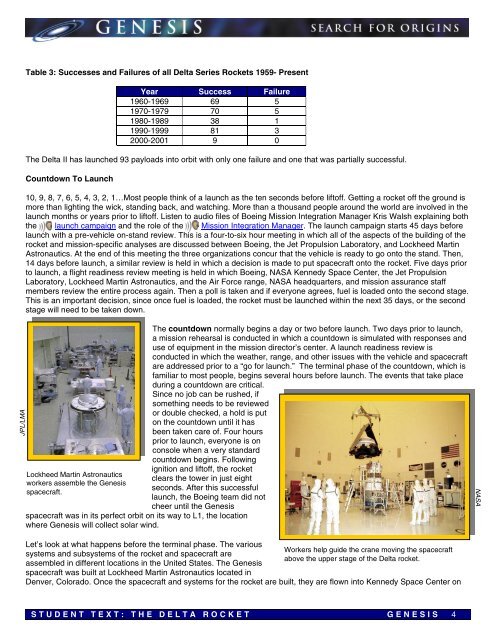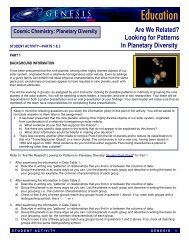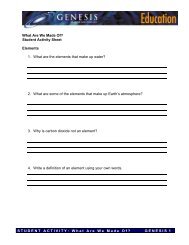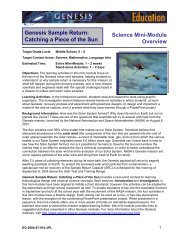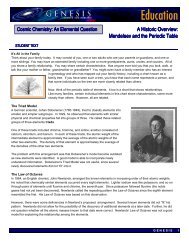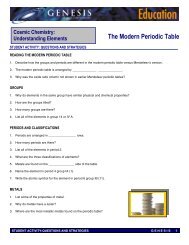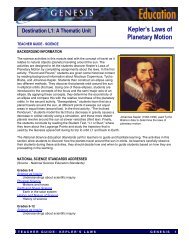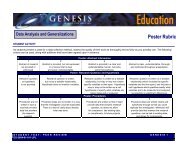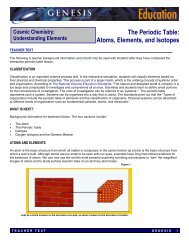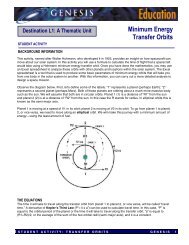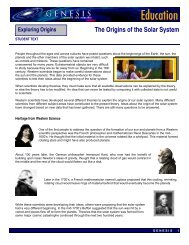Genesis Launch Vehicle: The Delta Rocket - Genesis - NASA
Genesis Launch Vehicle: The Delta Rocket - Genesis - NASA
Genesis Launch Vehicle: The Delta Rocket - Genesis - NASA
Create successful ePaper yourself
Turn your PDF publications into a flip-book with our unique Google optimized e-Paper software.
Table 3: Successes and Failures of all <strong>Delta</strong> Series <strong>Rocket</strong>s 1959- Present<br />
Year Success Failure<br />
1960-1969 69 5<br />
1970-1979 70 5<br />
1980-1989 38 1<br />
1990-1999 81 3<br />
2000-2001 9 0<br />
<strong>The</strong> <strong>Delta</strong> II has launched 93 payloads into orbit with only one failure and one that was partially successful.<br />
Countdown To <strong>Launch</strong><br />
10, 9, 8, 7, 6, 5, 4, 3, 2, 1…Most people think of a launch as the ten seconds before liftoff. Getting a rocket off the ground is<br />
more than lighting the wick, standing back, and watching. More than a thousand people around the world are involved in the<br />
launch months or years prior to liftoff. Listen to audio files of Boeing Mission Integration Manager Kris Walsh explaining both<br />
the launch campaign and the role of the Mission Integration Manager. <strong>The</strong> launch campaign starts 45 days before<br />
launch with a pre-vehicle on-stand review. This is a four-to-six hour meeting in which all of the aspects of the building of the<br />
rocket and mission-specific analyses are discussed between Boeing, the Jet Propulsion Laboratory, and Lockheed Martin<br />
Astronautics. At the end of this meeting the three organizations concur that the vehicle is ready to go onto the stand. <strong>The</strong>n,<br />
14 days before launch, a similar review is held in which a decision is made to put spacecraft onto the rocket. Five days prior<br />
to launch, a flight readiness review meeting is held in which Boeing, <strong>NASA</strong> Kennedy Space Center, the Jet Propulsion<br />
Laboratory, Lockheed Martin Astronautics, and the Air Force range, <strong>NASA</strong> headquarters, and mission assurance staff<br />
members review the entire process again. <strong>The</strong>n a poll is taken and if everyone agrees, fuel is loaded onto the second stage.<br />
This is an important decision, since once fuel is loaded, the rocket must be launched within the next 35 days, or the second<br />
stage will need to be taken down.<br />
JPL/LMA<br />
<strong>The</strong> countdown normally begins a day or two before launch. Two days prior to launch,<br />
a mission rehearsal is conducted in which a countdown is simulated with responses and<br />
use of equipment in the mission director’s center. A launch readiness review is<br />
conducted in which the weather, range, and other issues with the vehicle and spacecraft<br />
are addressed prior to a “go for launch.” <strong>The</strong> terminal phase of the countdown, which is<br />
familiar to most people, begins several hours before launch. <strong>The</strong> events that take place<br />
during a countdown are critical.<br />
Since no job can be rushed, if<br />
something needs to be reviewed<br />
or double checked, a hold is put<br />
on the countdown until it has<br />
been taken care of. Four hours<br />
prior to launch, everyone is on<br />
console when a very standard<br />
countdown begins. Following<br />
ignition and liftoff, the rocket<br />
Lockheed Martin Astronautics<br />
clears the tower in just eight<br />
workers assemble the <strong>Genesis</strong><br />
seconds. After this successful<br />
spacecraft.<br />
launch, the Boeing team did not<br />
cheer until the <strong>Genesis</strong><br />
spacecraft was in its perfect orbit on its way to L1, the location<br />
where <strong>Genesis</strong> will collect solar wind.<br />
<strong>NASA</strong><br />
Let’s look at what happens before the terminal phase. <strong>The</strong> various<br />
Workers help guide the crane moving the spacecraft<br />
systems and subsystems of the rocket and spacecraft are<br />
above the upper stage of the <strong>Delta</strong> rocket.<br />
assembled in different locations in the United States. <strong>The</strong> <strong>Genesis</strong><br />
spacecraft was built at Lockheed Martin Astronautics located in<br />
Denver, Colorado. Once the spacecraft and systems for the rocket are built, they are flown into Kennedy Space Center on<br />
STUD ENT TE XT: TH E DELTA RO CK ET<br />
G E N ESI S<br />
4


